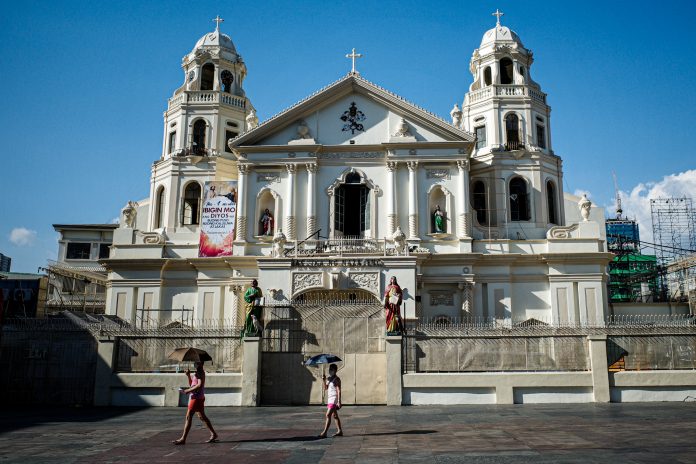Filipino Catholics can expect marked changes in how they can express their faith amid the COVID-19 pandemic.
Television news footage these days show every now and then a small group of devotees—about six to ten—gathered in fervent prayer outside the gates of the Quiapo Church in Manila.
The gates are closed, in keeping with the lockdown, or the “enhanced community quarantine” of Metro Manila, since March 15. But that does not stop them from converging in the small plaza which during the pre-COVID days used to be filled with people either selling candles and other religious goods or hearing Mass even from outside the church compound.
The TV images depict some devotees kneeling on the concrete pavement, others standing in quiet reflection in the direction of the entrance to the church, which holds the image of the Black Nazarene.
Those images are in stark contrast to what happens every January, when the Black Nazarene is the object of intense veneration by millions of Filipinos.
Will we be able to witness the same long and winding Black Nazarene processions in years past in 2021?
Not so, I would think, unless, of course, a cure or vaccine has already been found by then.
As of now, the Catholic faithful will have to abide by certain rules as part of what’s been described as the “new normal” in religious services.
The Archdiocese of Manila has already submitted proposals to the government on how parishes will resume liturgical celebrations.
The proposed protocol for religious services will limit the number of people present, ensure physical distancing, and require everyone in the congregation to wear face masks.
According to Bishop Broderick Pabillo, the archdiocese’s administrator, these measures will be strictly implemented when current lockdown restrictions are lifted.
A big change is that only ‘simple’ weddings with few people will be allowed in Manila’s Catholic churches this year, according to Bishop Pabillo.
Wedding entourages will be discouraged as part of temporary adjustments to be made “due to our extraordinary situation.”
Only the bride and the groom with one set of sponsors and the immediate family will be allowed. There will be no best man and bridesmaid for the meantime.
For baptism, only the parents and one set of godparents will be allowed for every baptismal candidate. Parishes are also encouraged to increase baptism schedules if there are many children to be baptized to decongest their churches.
Even funerals will also have limited attendance as only the immediate family would be allowed during Mass in the church.
People will also be advised not to bring their dead to the church anymore if a Mass has already been done during the wake.
As for confirmation, the Church will forego mass confirmations this year. Those to be baptized as adults or to get married can be confirmed by the parish priest as church discipline dictates.
Bishop Pabillo said parishes can stream church services online for those who cannot participate physically in weddings, baptisms, and funerals.
But while the Church is now using the internet as a tool for evangelization, it will retain traditional face-to-face confessions.
For Bishop Pabillo, the rites of penance require a personal dialogue between penitents and their confessor. This is also intended “to protect the secrecy and sincerity of confession,” he said.
Meantime, a Catholic archdiocese in Western Visayas is taking its traditional summer catechetical program to cyberspace amid strict quarantine in the region. The Capiz archdiocese is launching an online talk show to reach out to young people in various parishes and mission stations amid the lockdown. The archdiocese will not only stream out the catechesis to the audience, but viewers can also ask questions in the comments, making the program interactive.
Going online is the emerging trend not only for the Philippine Church but also for foreign dioceses.
In England, a new “dial-a-Mass” service enables Catholics with no internet connection to listen to Sunday Masses. When Catholics call the service, they hear a brief message welcoming them to the cathedral. A recording of the Sunday Mass then begins.
In addition to livestreaming Masses and Mass-by-Phone, the diocese is planning to hold a virtual pilgrimage to Lourdes after it was forced to postpone its regular trip to the French shrine at the end of May. The online pilgrimage will include services on Facebook as well as special prayers and reflections.
What other changes are forthcoming in the Church amid the COVID-19 pandemic? With the fast-changing landscape brought about by the deadly infection, churches will have to be creative in getting the faithful to take part in liturgical celebrations. After all, as has been said, the art of progress is to preserve order amid change, and to preserve change amid order.
Ernesto M. Hilario writes on political and social justice issues for various publications in the Philippines. The views and opinions expressed in this article are those of the author and do not necessarily reflect the official editorial position of LiCAS.news.









